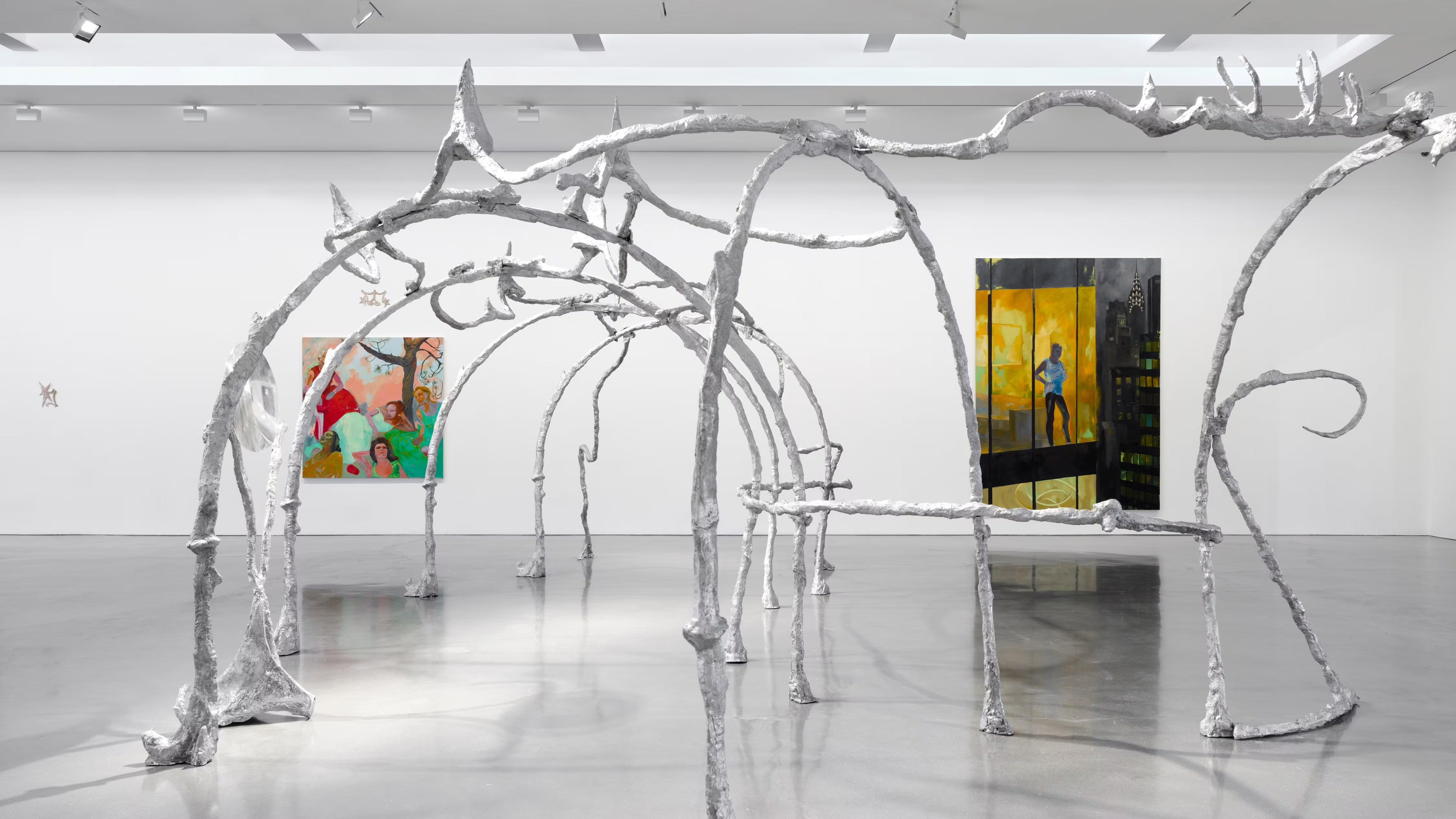
Taos’ dirt is sacred and bloodred. Overhead, the Sangre de Cristo Mountains ascend to the heavens and break into valleys that cradle the sun before popping its yolk into a shadow. Like all great places, it contains a dualism that splinters off into many directions. The tiny county at the northern tip of New Mexico is a place anchored in its past—both of ancestral knowledge and of settler colonialism. Spanish rancho. Century-long art haven. Forever home of the Taos Pueblo people. At 6,969 feet above sea level, the air is dry and piñon-scented. Stop to catch your breath, and you might notice animal bones poking out from the soil. Further up, sage bushes blur into a golden aspen glow.
Located 70 miles north of Santa Fe, Taos is best understood through its contrasts. In winter, the sun warms the air, and the night keeps the snow frozen. The famed Pueblo complex opens in the morning for visitors and closes in the afternoon. The ruins of a Catholic mission sit within, near a rebuilt church. Above it, a ski resort. Below, a casino. The municipal lines skirt Indigenous land, and peace manifests in boundaries. Much is communicated with a nod. To live here is to die here and become reborn as someone who can withstand the quiet and the climate.


Here resides the artist Kevin Cannon, who arrived for good from New York in 1990 and secured his coveted adobe home the next year. Since then, the artist has become one with the place. The exterior is faded and textured. The wood is worn. Trees cast shadows along the walls. Zoom out or in, it is a painting either way. “You never have to go too far for your subject matter,” says Cannon. “Looking out the window is all you need.”
Today he is standing out front of his home, the Pink House, on a bridge to nowhere—the land breaks off into charged territory that is left to the imagination and framed by his window, memorialized in his art. Cannon ducks under trees and weaves through high grass as he leads me across the property. The 76-year-old is dressed smartly in a beige uniform, a wool sweater and matching pants (a second pair hangs nearby on a clothing wire). It appears as if every detail was considered initially and then never thought of again. Bespectacled with a head of thick, wavy gray hair, the artist is framed by the mountain range.


Not much of the Pink House’s façade has changed since it was built by the Taos Pueblo over a century ago; its homeowner is adamant it remains that way. A single lollipop topiary tree hints at the world within. Inside, even the walls are untouched. Objects both found and made by Cannon populate every nook and cranny, as if they sprouted up like mushrooms. Shelves reveal rows of peculiar and sculptural pieces of wood and bones, what appears to be a worn down tennis ball, and various curiosities. Dried leaves are stuck to a piece of paper. A cup of deadstock toothbrushes rests atop the window sill. Delicate, earthy ceramics in the cupboard. Everything is in its place. “It’s not neatness, it’s order,” Cannon shares. In his back studio-bedroom, white sheets are draped over a stack of large sculptures on a table; the folds of the fabric reflect the shapes underneath.


Next door to the adobe where the artist lives is the Studio, which Cannon purchased in 2002 after having paid an initial year’s rent via two of his sculptures. The makeshift museum holds his sleek and structural leather sculptures and detailed graphite-on-paper still lifes. His works are displayed across the floor, the wall, a piano, wooden tables, and countertops. Three-legged stools from his late-’90s series are arranged like a mini army in the sparse living room. Nearby, objects from the late ’80s to early aughts propped on pedestals are mercurial, gravity-defying feats that capture the intricacies of a crumpled sheet or hanging towel.
Together, both buildings hold a robust archive of Cannon’s life’s work: approximately 75 leather sculptures, dozens of intricately layered photorealistic drawings, and thousands of minute-sketches of his everyday life, from scissors to flower studies to his own hand. There are playful, figurative shapes from the ’80s and sensual, abstract forms that sprung forth after—sometimes bulbous, sometimes spiky. Some stand atop leg-like stems, while others balance precariously on their contours. As we speak, one curls up atop his work desk, illuminated by a lamp.


At the foot of the hill beneath Cannon’s set up is the famed Mabel Dodge Luhan House, a.k.a. the Big House, now both a historic site and a bed-and-breakfast. The heart of the compound on which we stand was named after the heiress and socialite who moved to Taos in 1917. A striking figure with an Edwardian bob, she married Tony Lujan, adopted an anglicized version of her fourth husband’s last name, and bought land soon after in town. A Pueblo native, who had a handsome, angular face and wore his hair in a long, dark braid, Lujan oversaw the construction of the property, including the two buildings Cannon occupies.

The ghosts of the past are inextricable. Cannon’s property in fact was once a residency for various bohemian artist and writer friends of Dodge Luhan. Georgia O’Keeffe, Willa Cather, Dennis Hopper, and D.H. Lawrence all spent time in the Pink House; Carl Jung, Igor Stravinsky, and Tennessee Williams stayed in the Studio. Lawrence, who once lived in Cannon’s quarters, even painted the doors: Today, a cabinet with a delicate chrysanthemum in a vase remains—behind it, a suite of Cannon’s early sculptures. Minimalist yet primal, the artist’s work recalls at once the craftsmanship of JB Blunk, the sensual abrasion of Jean Arp, the corporeality of Louise Bourgeois, and the alchemy of John Chamberlain. Medieval Irish art, Indigenous craftsmanship, Bhutanese architecture, ancient Japanese ceramics. Yet the innovative and unconventional use of leather and obsessive dedication to form puts it in a league of its own. I ask him why he thinks he hasn’t had gallery representation despite being in famous collections throughout the country. “I’m looking for those who are looking for me,” he responds.


A decisive artist full of wonder, the best word to describe Cannon is the Japanese term shokunin: a master who has a holistic, spiritual devotion to his craft. His training in leatherwork can be traced back to a chance encounter with a storefront in Greenwich Village. “When I was 17 I walked by the window, and it changed my life,” he explains. What did he see? He points to his sandal-clad feet: “These.” After learning leatherwork at the sandal shop, he was hooked, finding ways to learn and live the craft. Before Taos, it was making sandals on the top floor of an old Victorian house in Westhampton Beach. Next, Wyoming to study saddle-making in 1974. Then, Taos, where he arrived with a saddle as his calling card. Back to New York City in 1983 before returning to New Mexico for good.
While he learned leather-making techniques from craftsmen, the art came on its own, “by trial and error—necessity. Have to. Want to. I need to,” Cannon says. “It’s not just happenstance,” he reveals: When Cannon was 40 years old, he discovered his maternal family had worked in leather going back centuries. “Stuff happens,” he adds, “be prepared.”


Cannon repeats this phrase like a mantra. A process artist and self-proclaimed control freak, he finds freedom in structure and likes slow, meditative work. His sculptures? Hollow, molded while wet, formed with few hand tools and little equipment. The shiny, protective surface smoothed and burnished with bone. Painstakingly painted with thin layers of acrylic. The leather: sourced from a tannery in St. Louis, Missouri. Made from organic materials and a mix of traditional techniques and ingenuity, labored over for countless hours by hand, the works share a spirit—even in form—with the houses, which were sculpted from raw earth, straw, and water into shapes that transform from every angle.
Here, doorways are curved, some so low you have to stoop. Step back, and every entryway frames one of Cannon’s objects. Look up, and vigas make up the ceiling. The rows of pine beams culled from the forest enclose the works below. Unlike modern ideas of living, in Taos the land doesn’t end where structures start. It pours in through windows and doorways. The trees on the mountains, so close you might reach out and touch them. The taste of dirt trickles down your nose and into your throat. The scent of sage, strong. Everything shifts with the sun.


“What was it like last night when you looked out there? It was dark, right? Completely dark,” Cannon asks as the sun casts a long white stripe into the kitchen. “Now look at it. It does this every day. All of a sudden, it’s lifted. Dark and light. It’s all about balance. Everything’s like that,” he muses. “Here nature is God. The sun comes up and down every day. That’s reality,” says Cannon as a phone rings from another room. “Let me see who that is,” he tells me as he heads to answer the call. “Could be God.”









.avif)








.avif)


_result_result.avif)



.avif)

_result_result.avif)

_result_result.avif)
.avif)

_result_result.avif)


_result_result.avif)


.avif)




.webp)

.avif)















%20(1).avif)
.avif)




.avif)















.avif)


.avif)





















.jpeg)

.avif)

_11%20x%2014%20inches%20(2).jpg)







.avif)

.jpg)

%20(1).jpg)
.avif)
.jpg)

.jpg)
.webp)


.webp)



.webp)


.webp)


.avif)












.avif)
.avif)





.avif)












.avif)



.avif)




















-min_result.avif)









.avif)







3_result.avif)
_result.avif)






_result.avif)




.avif)




.avif)













_result.avif)




%2520(1)_result.avif)
_result.avif)


.avif)

.avif)







.avif)

.avif)










.avif)



.avif)


_result_result.avif)
















-min_result.avif)






.avif)
.jpg)
















_result.avif)

.avif)


.avif)







.avif)





.avif)

_result.avif)



.avif)









.avif)









.avif)


.avif)














.avif)




.avif)








.avif)

.avif)

.avif)



.avif)


.avif)




.avif)

.avif)

.avif)
.avif)
%20(1).avif)
.jpg)

%20(1).avif)








.avif)
.avif)

.avif)






.avif)


.avif)
.avif)





















.avif)
.avif)
